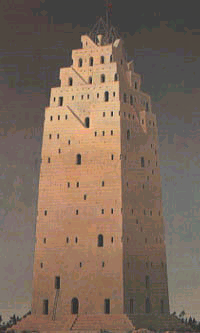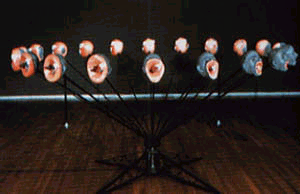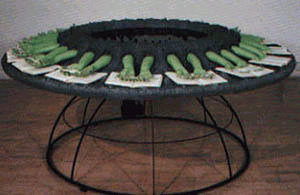|
Wonderland
|
|
| Maybe it is Freud's fault that dreams and fantasy seem stuck in
time at the end of the 19th century. These two exhibitions are very Victorian.
All the work in the Territory of Fantasy, Figurative Paintings from the
Terada Collection uses Victorian imagery and styles of illustration. While
Dream Reality: The Animated Sculpture of Gregory Barsamian, is based on
a toy which made moving images in the 19th century before the invention
of movies. |
|
|
The exhibition Territory of Fantasy contains over one hundred
works by about 20 Japanese artists who in a variety of media including
oil and acrylic paint, etching and pencil drawings have explored the territory
of their subconscious minds. An "Alice in Wonderland" atmosphere pervades
the works in Territory of Fantasy where artists have often included in
their works bearded European figures with top hats and Victorian costume.
In his large acrylic paintings Minoru Nomata creates fantasy landscapes
with structures and scaffolding holding up part of the earth. In the cliffs
a Lillypillian society seems to dwell. His trees and skies borrow heavily
from a 19th Century landscape tradition.
In contrast Ryosuke Kawauchi creates immaculate little drawings
that cause a chuckle -- monkeys fly over machines which are controlled
by koalas and supported by insects, while earnest dark men in suits watch
on. His pencil drawings are a marvel of realism and a wonder of inventiveness.
What matter that Max Ernst tapped the same sources in his collages at
the beginning of the last century.
|
 |
| Territory of Fantasy makes no claim to tread new artistic ground.
The exhibition delights in its whimsy and technical brilliance. |
|
| Float on up to the NTT InterCommunication Center in the same building
to experience the exhibition Dream Reality: The Animated Sculpture of Gregory
Barsamian. By taking a series of sculptured objects each a little different
from the last, spinning them around with an electoric motor and then using
a strobe light to give a still snapshot image of the sculptures, Barsamian
fools our minds eye that the sculptures come to life. The technique originates
in a Victorian game parlor object called a Zoetrope, which was the forerunner
to moving images. Like modern movies, Barsamian sculptures rely on mechanical
movement and the persistence of vision. Movies use a shuttered projector
and still photographic images at the rate of 24 frames per second to create
a series of instant stills which our mind perceives as motion -- Barsamian
uses up to 16 rapidly rotating sculptures and a strobe light to "shutter"
the images in our mind. The principle remains the same and is wholly of
the machine age, nothing virtual here. |
|
The Scream (1998) Barsamian takes a sculpture of his own head and
literally turns it inside out. However,this head dumping does not reveal
the dreams of the unconscious mind but rather the distractions of an everyday
life. Emerging from his ever-expanding mouth are the everyday flotsam and
jetsam of life -- keys, half tube of toothpaste, a house and a boot.
In Dipping Digits (Always get wet) on the other hand is a lyrical
piece where green hands scoop into the pages of a book. There they grapple
to catch an illusive lizard. While in the middle a primeval slime bubbles,
boils and brews the origins of life, words wash around forming poetry and
art.
"Somehow it seems to fill my head with ideas -- only I don't exactly
know what they are!" said Alice in Through the Looking Glass. A similar
wonder pervades these two exhibitions both currently on display at the Tokyo
Opera City complex. |
|
| |
|
| |
|


